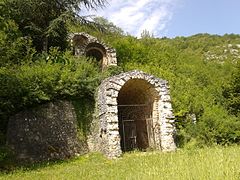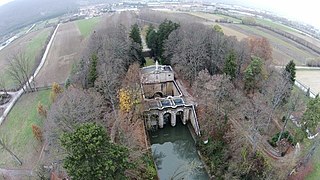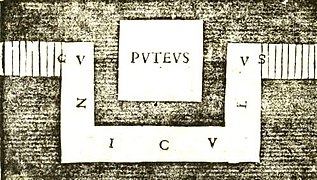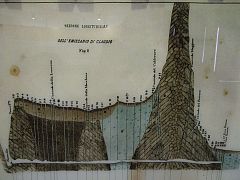Claudius tunnel
| Claudius tunnel | |
|---|---|
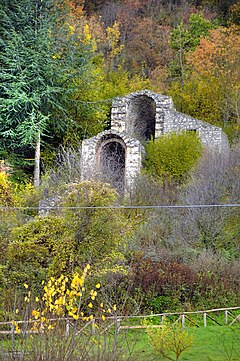 Exit of the main tunnel |
|
| Data | |
| Year of construction / construction time: | 1st century AD |
| Conversion / adult: | 6th century AD |
| Original use: | Drainage of Lake Fucin |
The Claudius Tunnel (Italian : Cunicoli di Claudio ) is a hydraulic structure that was built on behalf of the Roman Emperor Claudius between AD 41 and 52 to regulate the water level in Lake Fucin . The system consists of a long underground canal, six shafts and 32 wells. With a length of more than 5.6 km, it was the longest tunnel ever built until the opening of the Mont-Cenis railway tunnel in 1871.
history
Original plans
Already Julius Caesar planned the draining of the lake to make available to the terrain. His murder prevented the realization of the plans.
Construction and expansion
The tunnel, where up to 30,000 workers dug over a period of 11 years, was driven in a light shaft. For this purpose, inclined shafts were repeatedly sunk from the surface, which were connected by vertical shafts. These shafts were mainly used for orientation, but excavated material could also be transported over them. After about 3.4 km of the 5.6 km long tunnel, the workers came across a heavily water-bearing layer of clay and rock, which even made it necessary to use scooping devices. In this area there was an 85 m long collapse already during the construction phase or shortly afterwards, which was then bypassed with a bypass. The tunnel was repaired and expanded under Hadrian .
Decay
After the fall of the Roman Empire and the barbarian invasion, there was no maintenance work and the main canal gradually clogged. During the Middle Ages - possibly under Frederick II - there was another collapse in the bypass section, which was repaired. However, these efforts did not last either, and the lake water level was gradually rising again.
New buildings in the 19th century
In the 19th century, several places were threatened by the steadily rising water masses. From 1854 Alessandro Torlonia had a new canal built using the old systems in part. This successfully drained the lake completely.
20th and 21st centuries
In 1902 the complex was declared an Italian national monument. The facility is of particular archaeological and speleological interest. It has been embedded in a park since 1977, which is intended to protect it, but also to support research. In 2017, funds were made available for the management of the archaeological park by the Chamber of Commerce of L'Aquila , the municipality of Avezzano and the local action group ( gruppo di azione locale ) Terre Aquilane .
Picture gallery
Individual evidence
- ^ Bernhard Maidl: Fascination tunnel construction: history and stories . Ernst and Son, Berlin 2018, ISBN 978-3-433-03113-1 .
- ↑ Pliny the Elder: Naturalis Historia 36,124
- ↑ Historia Augusta: Hadrianus 22
- ↑ Cunicoli di Claudio, firmato il protocollo per la valorizzazione del parco archeologico ( it ) PatrimonioSos. January 24, 2017. Retrieved June 13, 2017.
- ↑ Abruzzo, erogati i primi Finanziamenti per valorizzare i Cunicoli di Claudio ad Avezzano ( it ) Il Giornale dell'Arte. June 9, 2017. Retrieved June 13, 2017.
Coordinates: 41 ° 59 ′ 18.7 ″ N , 13 ° 26 ′ 0.2 ″ E

